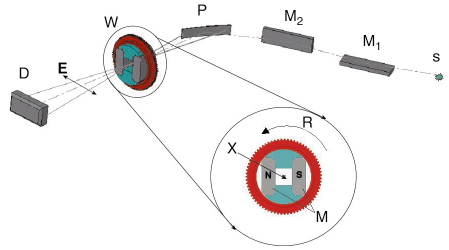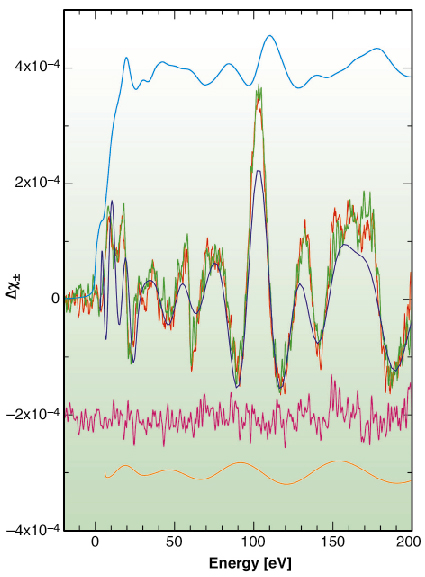- Home
- Users & Science
- Scientific Documentation
- ESRF Highlights
- ESRF Highlights 2005
- X-ray Absorption and Magnetic Scattering
- Measurements of Femtometre-scale Atomic Displacements by X-ray Absorption Spectroscopy
Measurements of Femtometre-scale Atomic Displacements by X-ray Absorption Spectroscopy
Displacements of atoms from their equilibrium distance, which are of the order of femtometres, are common in a variety of effects. For example, magnetostriction involves tiny mean atomic displacements that add up to give a macroscopically measurable quantity. Magnetostriction can be sensed as the buzz of a transformer, and used in under-water acoustic generation. We have measured the mean atomic displacement for atoms undergoing magnetostriction in an iron-cobalt alloy by employing the subtle changes observed in an X-ray absorption spectrum when the relative orientation between the photon polarisation vector and the sample magnetisation vector is changed. This technique is an advance on the widely-used EXAFS. Hitherto, displacements of atoms surrounding an absorber atom could be monitored to an accuracy of about 0.001 Å. An analysis of this limitation, lead us to conclude that two things set this limit. The first limitation was the signal to noise ratio of the measurement, and the second, the energy stability between comparative measurements. Encouraged by the success of the measurement at extreme conditions of X-ray Magnetic Circular Dichroism (XMCD) on ID24 [1], which measures the difference in absorption between two helicity states of the photon, we decided to attempt a measurement of the much weaker X-ray Magnetic Linear Dichroism (XMLD) over an extended energy range, i.e. the difference in EXAFS caused by magnetostrictive atom movement. ID24 provides an excellent environment for this type of measurement as it has an undulator as its source, which provides a high intensity to give a good signal to noise ratio. Also it has no moving parts, which aids the energy stability. A rough calculation of the anticipated size of the effect to be measured is ~ 10-4 (fractional change in normalised absorption) which requires a signal to noise ratio of about one decade better than this and also an energy stability of better than 0.01 eV.
Our apparatus for performing this measurement is shown schematically in Figure 125. The source, S, is the 42-pole planar undulator of ID24, which is focussed vertically and horizontally by mirrors M1 and M2 respectively, the latter producing an image before the bent silicon crystal polychromator P. This optic selects wavelengths of the incident X-ray flux and disperses them onto a linear detector D. S, M1, M2, P and D are standard components of ID24. In addition the polychromator also focuses the beam onto the sample X (inset) that is held in an inert environment inside a wheel W that houses permanent magnets. The wheel rotates 90° between measurements and four measurements take approximately one second. This means that our apparently unreasonable requirement of 0.01 eV stability becomes reasonable when it is only required over a one second period.
 |
|
Fig. 125: A schematic of the experimental layout. |
Some measurements are presented in Figure 126, which shows the differential EXAFS signal, red and green curves (these are two independent measurements with a 90° phase difference in the sequence of measurement and one curve has been inverted for comparison). The dark blue line gives a theoretical prediction of the curves, using macroscopically measured tensor coefficients. The light blue curve is a measurement of the K absorption edge of the FeCo sample on the same energy scale as the differential signal. Note that on the scale of this diagram the differences between two absorption spectra are too small to be seen.
 |
|
Fig. 126: The magnetostrictive differential EXAFS signal. |
In Figure 126, the purple curve is a measure of the experimental noise and for comparison the brown curve is a theoretical prediction of the effect of a 1 femtometre displacement of the first shell atoms, which could be detected. These results show that EXAFS sensitivity can be extended to include atomic displacements of the order of 0.00001 Å, which is about 100 times smaller than had previously been assumed. This puts EXAFS sensitivity well within the range of thermal expansion over a temperature of one degree, piezo-effects, strictive-effects and elastic phenomena. All of these phenomena with the exception of piezo-effects are manifested in amorphous materials where the power of EXAFS as a structural technique is maximal. With advances in instrumentation we expect that the sensitivity can be improved by another decade.
References
[1] O. Mathon, F. Baudelet, J.P. Itié, S. Pasternak, A. Polian, S. Pascarelli, Journal of Synchrotron Radiation 11, 423 (2004).
Principal publication and Authors
R.F. Pettifer (a), O. Mathon (b), S. Pascarelli (b), M.D. Cooke (c) and M.R.J. Gibbs (c)
Nature 435 78-81 (2005)
(a) Department of Physics, University of Warwick, Coventry (UK)
(b) ESRF
(c) Department of Engineering Materials, University of Sheffield, (UK)



